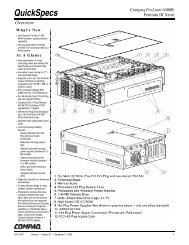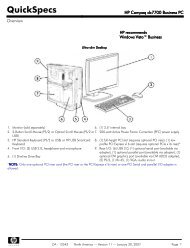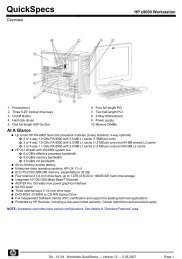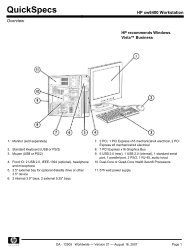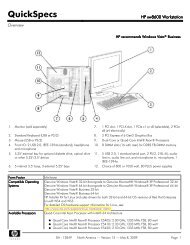HP Compaq dc5800 Business PC - NTS Computers Technology
HP Compaq dc5800 Business PC - NTS Computers Technology
HP Compaq dc5800 Business PC - NTS Computers Technology
You also want an ePaper? Increase the reach of your titles
YUMPU automatically turns print PDFs into web optimized ePapers that Google loves.
QuickSpecs<br />
<strong>HP</strong> <strong>Compaq</strong> <strong>dc5800</strong> <strong>Business</strong> <strong>PC</strong><br />
Technical Specifications<br />
ROM BIOS Information<br />
Key features of the <strong>HP</strong> BIOS in the <strong>dc5800</strong> include:<br />
Deployment and manageability – <strong>HP</strong> BIOS provides several technologies that help integrate the <strong>HP</strong> <strong>Business</strong> desktop computer<br />
into the enterprise, such as PXE, remote configuration, remote control, and F10 Setup support for 12 languages.<br />
Stability – <strong>HP</strong> BIOS supports the <strong>HP</strong> stable product roadmap by releasing only critical BIOS changes to the factory and<br />
advanced change notification.<br />
Security – <strong>HP</strong> BIOS offers a robust and flexible set of security features to help the system administrator secure their systems from<br />
removal of sensitive data, and help prevent access by unauthorized users.<br />
Tracking and tracing capabilities in case of theft available in select countries (subscription sold separately).<br />
Thermal and power management – The <strong>HP</strong> BIOS provides and enables thermal and power management technologies to assist<br />
in operating the <strong>HP</strong> <strong>Business</strong> Desktop computer in any enterprise environment.<br />
Serviceability – <strong>HP</strong> BIOS provides diagnostic and detailed service information.<br />
Upgrades and recovery – <strong>HP</strong> BIOS provides numerous ways to upgrade <strong>HP</strong> <strong>Business</strong> Desktop computers, including BIOS<br />
updates from within DOS (Flashlite), BIOS updates from within Windows (<strong>HP</strong>QFlash, SSM), <strong>HP</strong> Client Manager, and fail-safe<br />
recovery. In addition, the <strong>HP</strong> <strong>Business</strong> Desktop BIOS Utilities tool enables replicated BIOS setup throughout the Enterprise; it is<br />
available from within the BIOS software and from the support website.<br />
Additional <strong>HP</strong> BIOS Features<br />
Administrator password – Also known as the setup password, this helps prevent unauthorized changes to the system<br />
configuration. If the administrator password is not known, the BIOS version cannot be changed and changes cannot be made<br />
to BIOS settings using F10 setup or under the OS.<br />
Advanced Configuration and Power Interface (ACPI) – Represents a significant innovation in power and configuration<br />
management, allowing operating systems and applications to manage power based on activity and usage. Provides power<br />
conservation features under Windows XP.<br />
Ability to mute the internal speaker<br />
Other Features<br />
ACPI-Ready Hardware<br />
Description<br />
Advanced Configuration and Power Management Interface (ACPI).<br />
SMBIOS Ver. 2.4<br />
Wired for Management Support<br />
Dual-State Power Button<br />
Allows the system to wake from a low power mode.<br />
Controls system power consumption, making it possible to place individual cards<br />
and peripherals in a low-power or powered-off state without affecting other<br />
elements of the system.<br />
System Management BIOS, previously known as DMI BIOS, for system management<br />
information<br />
Intel-driven, industry-wide initiative to make Intel architecture-based <strong>PC</strong>s, servers and<br />
mobile computers more inherently manageable right out of the box and over the network<br />
Power button acts as both an on/off button and suspend-to-sleep button<br />
Serviceability Features of System<br />
Dual Color Power LED on Front of Computer (Indicates Normal Operations and Fault Conditions)<br />
Diagnostic LED Explanation Table Number of 1-second red LED blinks followed by 2-second pause, then repeats:<br />
2-processor thermal protection activated<br />
3-processor not installed<br />
4-power supply failure<br />
5-memory error<br />
6-video error<br />
7-<strong>PC</strong>A failure (ROM detected failure prior to video)<br />
8-invalid ROM, bootblock recover mode<br />
System/Emergency ROM Flash ROM CMOS Battery Holder for easy<br />
Replacement<br />
Flash Recovery with Video 5 Aux Power LED on System <strong>PC</strong>A Processor ZIF Socket for easy Upgrade<br />
Over-Temp Warning on Screen Clear Password Jumper<br />
DIMM Connectors for easy Upgrade<br />
(Requires IM Agents)<br />
Restore CD Clear CMOS Switch NIC LEDs (integrated) (Green & Amber)<br />
DA - 12863 Worldwide QuickSpecs — Version 3 — 4/2/2008 Page 14






